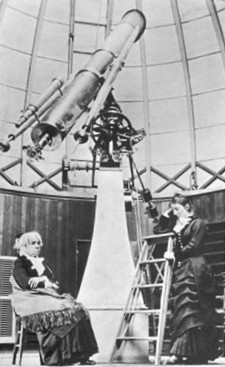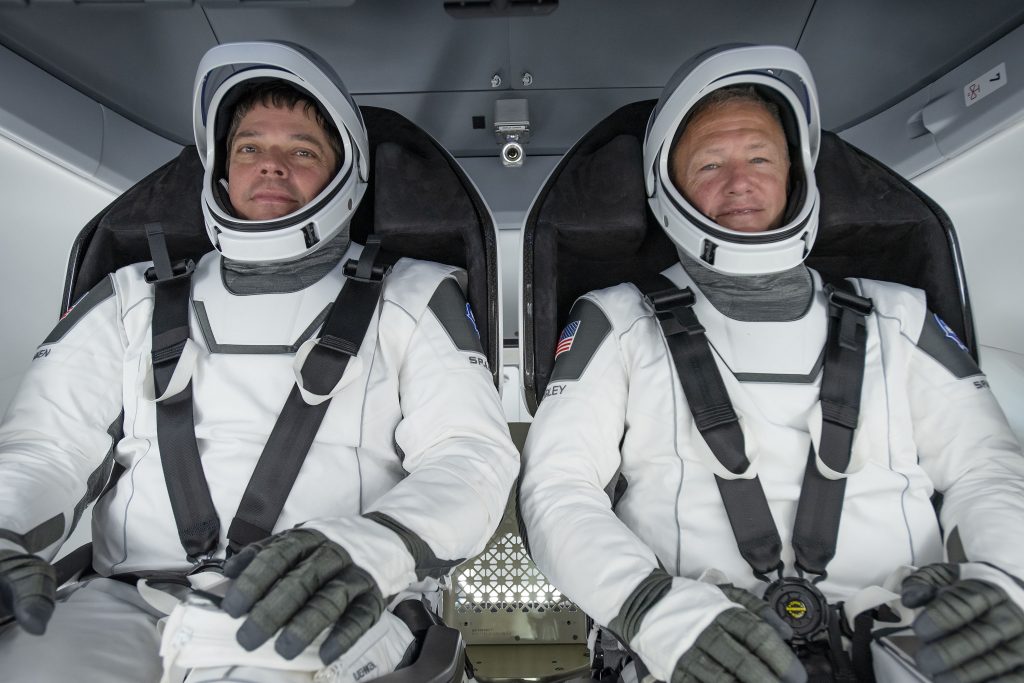
Photograph of Maria Mitchell (on left), circa 1877, in the Vassar College Observatory. America's first female, professional astronomer, she was also a leading 19th century women's suffragist. The telescope was a Fitz 12 and 3/8-inch refractor, the fourth largest telescope in the world when installed in 1863.
(Image Sources: Wikipedia.org, By Eva March Tappan - Heroes of Progress: Stories of Sucessful Americans (page 59), Public Domain, https://commons.wikimedia.org/w/index.php?curid=3257406)
By Glenn A. Walsh
Reporting for SpaceWatchtower
Today, we celebrate the annual Women's
Equality Day. But this year marks a special Women's Equality Day. Today is the
centennial of the certification of the 19th Amendment to
the United States Constitution, which prohibits the Federal
Government and the states from denying the right to vote to U.S.
citizens on the basis of sex. And, today we remember a leading
women's suffragist of the 19th century, who was America's
first female, professional astronomer.
Maria Mitchell, Professor of Astronomy
at Vassar College and discoverer of Miss Mitchell's Comet, was our
nation's first female, professional astronomer. She also helped
found, and was the second President of, the Association for the
Advancement of Women. And, she was an early and strong advocate for
education for girls and young women, particularly science and
mathematics education.
Born 202 years and 25 days ago (1818
August 1) in Nantucket, Massachusetts, Maria Mitchell was born to a
father (William Mitchell) who was a school-teacher, school-principal,
and amateur astronomer and a mother (Lydia Coleman Mitchell) who
worked at a library. She was raised in the Quaker faith, which valued
education for both boys and girls. Her father taught his ten children
(she was the third-born) all about nature and astronomy, while her
mother helped provide access to the two libraries where she was
employed.
At age 12, Maria Mitchell helped her
father use solar eclipse timing observations to calculate the
position of their home. Two years later, sailors trusted her
navigational calculations for their long whaling expeditions.
After completing a Unitarian school for
young ladies at age 16, she became a teaching assistant at the school
before opening her own school in 1835. In her school, she developed
experimental teaching techniques, as well as admitting non-white
students, a controversial move as the local public school was still
segregated.
Beginning in 1836, Maria Mitchell spent
20 years as the first librarian of the Nantucket Atheneum. As the
institution had limited hours, she also assisted her father with
astronomical observations and geographical calculations for the U.S.
Coast Survey.
She and her father used a 4-inch
equatorial telescope, provided by the U.S. Coast Survey, mounted in a
small observatory on the roof of the Pacific Bank Building; her
father was also a bank cashier. They used the telescope to find
nebulae and double stars, as well as producing latitudes and
longitudes by calculating the altitudes of stars and the culminations
and occultations of the Moon. She also continued her education.
Maria Mitchell started to practice the
Unitarian faith in 1843. She then became a committed abolitionist,
refusing even to wear clothes made from Southern cotton. She also
started to gain an interest in the women's rights movement,
befriending women's suffragists including Elizabeth Cady Stanton.
Maria Mitchell discovered Comet 1847 VI
(later, officially known as C/1847 T1), using a Dolland 3-inch
refractor telescope (46-inch focal length) at 10:50 p.m. on 1847
October 1. She was the first American and third woman to discover a
comet.
At the time, our young nation did not
have much of a reputation, among European scientists, for scientific
investigation and discovery. Hence, such a discovery by an American
was nearly as uncommon as such a discovery by a woman. With her comet
discovery, she soon became an international celebrity, being the
subject of numerous newspaper and magazine articles.
When the comet discovery was officially
recognized, on 1848 February 11, it became known as Miss
Mitchell's Comet. Maria Mitchell
was honored for the discovery at the Seneca Falls Convention, the
first women's rights convention, which occurred on July 19 and 20 in
1848. She was considered an excellent role model for women in
science.
Later in 1848, King Christian VIII of
Denmark awarded Maria Mitchell a gold medal prize for the comet
discovery. This award had been established by King Frederick VI to
honor the “first discoverer” of telescopic comets, comets
too faint to be seen with naked-eyes (one-power). The only previous
women to discover comets were German astronomers Caroline Herschel
and Maria Margarethe Kirch.
In 1849, Maria Mitchell began
working as a “computer” for the U.S. Coast Survey at the U.S.
Nautical Almanac Office. She tracked the movements of the planets,
particularly Venus. The tables of planetary positions she compiled
helped sailors in navigation.
In 1865, Maria Mitchell was appointed
the first professor of the newly-founded (1861) Vassar Female College (now
Vassar College) in Poughkeepsie, New York, located in the Hudson
River Valley north of New York City, by college founder Matthew
Vassar. Vassar Female College was only the second degree-granting institution of higher education for women in America, established soon after the 1855 founding of Elmira College, America's first degree-granting institution of higher education for women.
Maria Mitchell became the first Vassar Female College Professor, even though she, herself, did not have a college degree. During her tenure of more than 20 years, Vassar College enrolled more students in astronomy and mathematics than were enrolled in those subjects at Harvard University!
Maria Mitchell became the first Vassar Female College Professor, even though she, herself, did not have a college degree. During her tenure of more than 20 years, Vassar College enrolled more students in astronomy and mathematics than were enrolled in those subjects at Harvard University!
In addition to being Professor of
Astronomy, she was also named the first Director of the Vassar
College Observatory. The primary instrument of the observatory, a 12
and 3/8-inch refracting telescope produced
by celebrated telescope-maker Henry Fitz, was the fourth
largest telescope in the world when it was installed in 1863. It was
exceeded in size only by 15-inch refractors at Harvard College and in
Russia, and by a 13-inch Fitz refractor at the Allegheny Observatory (installed just two years earlier).
Maria Mitchell was Observatory Director and Professor of Astronomy
until 1888, about a year before her death.
While at Vassar College, she edited the
astronomical column in Scientific American Magazine. She also
wrote seven articles for Great Britain's Royal Society Catalog,
and in Silliman's Journal (better known as the American
Journal of Science, the longest-running U.S. scientific journal)
she published three articles detailing her astronomical observations.
Maria Mitchell's unconventional
teaching techniques included small classes and individualized
attention to students, as well as not recording grades or absences.
Lessons included mathematics and technology of the day. She realized
the career options for female students were limited, at that time.
However, she once said, “I cannot expect to make astronomers, but I
do expect that you will invigorate your minds by the effort at
healthy modes of thinking. When we are chafed and fretted by small
cares, a look at the stars will show us the littleness of our own
interests”.
With the Vassar College Observatory,
Maria Mitchell started an astronomical research program including
photography of the planets and their moons. Although she had started
recording sunspots by eye-sight in 1868, she and her students started
photographing sunspots daily in 1873. These were the first regular
photographs of the Sun, which allowed her to hypothesize that
sunspots were cavities on the Sun's surface, rather than clouds in
the solar atmosphere as was previously conjectured.
She also studied nebulae, double stars,
and solar eclipses. She developed theories regarding the orbiting of
stars in double star systems and the influence of distance and
chemical composition in star color variation.
For the solar eclipse of 1878 July 29,
Maria Mitchell and five assistants took observations from Denver,
using a 4-inch telescope. Her efforts led to the success of the
Vassar College science and astronomy programs, with 25 of her
students going on to be featured in Who's Who in America.
In 1873, after returning from a trip to
Europe, Maria Mitchell joined the national women's movement and
helped to found the Association for the Advancement of Women (AAW),
dedicated to educational reform and the advancement of women in
higher education. She was the second AAW president in 1875 and 1876.
After her presidency, she formed an AAW special Committee on Science,
which she headed until her death in 1889.
She taught at Vassar College until
1888, retiring, due to ill health, one year before her death; she
never married. She and the one other female professor succeeded in
gaining salary increases, when learning the greater salaries of their
male colleagues.
Maria Mitchell was the first woman
elected a Fellow of the American Academy of Arts and Sciences in
1848. In 1850, she joined the American Association for the
Advancement of Science. She was among the first women elected to the
American Philosophical Society in 1869. She received honorary degrees
from Hanover College, Columbia University, and Rutgers Female
College.
Maria Mitchell died of a brain disease,
at the age of 70, on 1889 June 28 in the Boston suburb of Lynn,
Massachusetts; she is buried in Nantucket next to her parents. The
Maria Mitchell Association was established in her memory in
Nantucket, to promote the sciences and preserve Miss Mitchell's work.
The Association owns the Maria Mitchell Observatory, a second
observatory, natural history museum, aquarium, science library, and
Maria Mitchell's Home Museum.
One of Maria Mitchell's favorite
quotes: "We especially need imagination in
science. It is not all mathematics, nor all logic, but it is somewhat
beauty and poetry."
Internet Links to Additional Information ---
Women's Equality Day: Link >>> https://en.wikipedia.org/wiki/Women's_Equality_Day
More information on Maria Mitchell -
Link 1 >>> https://www.biography.com/scientist/maria-mitchell
Link 2 >>> https://www.mariamitchell.org/about/about-maria-mitchell
Link 3 >>> https://www.womenshistory.org/education-resources/biographies/maria-mitchell
Link 4 >>> https://www.amightygirl.com/blog?p=25283
Link 5 >>> https://www.britannica.com/biography/Maria-Mitchell
Link 6 >>> https://en.wikipedia.org/wiki/Maria_Mitchell
Link 7 >>> https://www.nature.com/articles/d41586-018-05458-6
Maria Mitchell Association: Link >>> https://www.mariamitchell.org/
Miss Mitchell's Comet -
Link 1 >>> https://www.thevintagenews.com/2017/09/21/miss-mitchells-comet-was-discovered-by-a-female-astronomer-in-1847/
Link 2 >>> https://en.wikipedia.org/wiki/C/1847_T1
Vassar College Observatory: Link >>> https://en.wikipedia.org/wiki/Vassar_College_Observatory
Maria Mitchell Observatory: Link >>> https://en.wikipedia.org/wiki/Maria_Mitchell_Observatory
Related Blog Posts ---
"Female Astrophysicist Helped Build 1st Atomic Bomb." Thur., 2020 Aug. 6.
Link >>> https://spacewatchtower.blogspot.com/2020/08/female-astrophysicist-helped-build-1st.html?showComment=1597427681414
"Astronomical Calendar: 2013 August." Thur., 2013 Aug. 1.
Image of America's first professional woman astronomer, Maria Mitchell, whose 195th birthday is August 1 of 2013.
Link >>> https://spacewatchtower.blogspot.com/2013/08/astronomical-calendar-2013-august.html
Source: Glenn A. Walsh Reporting for SpaceWatchtower, a project of Friends of the Zeiss.
Wednesday, 2020 August 26.
Like This Post? Please Share!
More Astronomy & Science News - SpaceWatchtower Twitter Feed:
Link >>> https://twitter.com/spacewatchtower
Astronomy & Science Links: Link >>> http://buhlplanetarium.tripod.com/#sciencelinks
Want to receive SpaceWatchtower blog posts in your in-box ?
Send request to < spacewatchtower@planetarium.cc >.
gaw
Glenn A. Walsh, Informal Science Educator & Communicator:
< http://buhlplanetarium2.tripod.com/weblog/spacewatchtower/gaw/ >
Electronic Mail: < gawalsh@planetarium.cc >
Project Director, Friends of the Zeiss: < http://buhlplanetarium.tripod.com/fotz/ >
SpaceWatchtower Editor / Author: < http://spacewatchtower.blogspot.com/ >
Formerly Astronomical Observatory Coordinator & Planetarium Lecturer, original Buhl Planetarium & Institute of Popular Science (a.k.a. Buhl Science Center), Pittsburgh's science & technology museum from 1939 to 1991.
Formerly Trustee, Andrew Carnegie Free Library and Music Hall, Pittsburgh suburb of Carnegie, Pennsylvania.
Author of History Web Sites on the Internet --
* Buhl Planetarium, Pittsburgh:
< http://www.planetarium.
* Adler Planetarium, Chicago:
< http://adlerplanetarium.
* Astronomer, Educator, Optician John A. Brashear:
< http://johnbrashear.tripod.com >
* Andrew Carnegie & Carnegie Libraries:
< http://www.andrewcarnegie.


